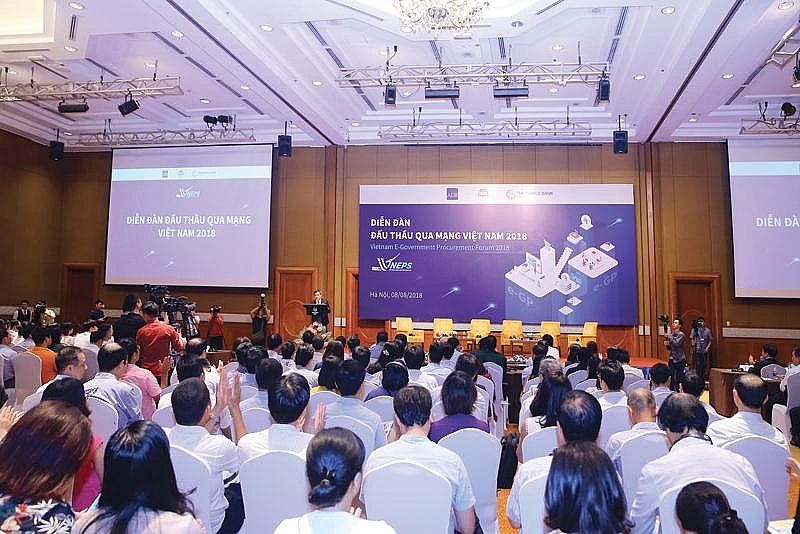Larger e-procurement packages up for grabs
 |
| Larger e-procurement packages up for grabs |
At Vietnam’s first-ever e-Government Procurement (eGP) Forum held last week, Nguyen Dang Truong, director of the Ministry of Planning and Investment’s Public Procurement Agency (PPA), said that the eGP system presently targets just small packages and focuses on regular shopping. The PPA is working to upgrade the system, while completing the necessary legal framework to facilitate bigger packages.
“We have issued a circular to open the application of the eGP system to larger packages,” Truong told VIR. “With targeted expansion into areas such as construction, goods, and services, we plan on opening up more opportunities for bidders.”
Truong elaborated that the opportunities will further open up when centralised public procurement is done online. Ministries and localities, including the ministries of Defence, Public Security, and Health, have indicated large demands for regular procurements.
Currently, foreign businesses are interested in public procurements, but their opportunities remain limited as local companies are currently given top priority, with foreign counterparts only receiving the opportunity for public procurement when domestic companies exhibit an incapability to do so. An exception to this is with commitments to specific free trade agreements.
For example, after the EU-Vietnam Free Trade Agreement (EVFTA) takes effect, EU companies will, for the first time, be able to bid on public procurement contracts in Vietnam under the same conditions as Vietnamese counterparts. This applies for a select number of entities, such as Electricity of Vietnam (EVN) and Vietnam Railways. Currently, EU companies are not allowed to engage in bidding activities for government-funded projects.
State-run EVN spends around $4-5 billion on projects per year, with many procurement contracts continuously becoming available to bidders. According to Pham Thi Thuy Ha, director of EVN’s Procurement Department, EVN saw 100 e-procurement packages in 2009, with the figure rising to 300 per year during 2010-2012, 1,800 in 2016, nearly 4,000 in 2017.
The multilateral development banks such as the Asian Development Bank (ADB) and the World Bank (WB) are foreseeing bright prospects for bids into these projects.
Adu-Gyamfi Abunyewa, senior procurement specialist at the WB, told VIR that, with over 70 per cent of all procurements financed under the WB-funded projects being conducted through national competitive bidding of up to $20 million per package, there will be a huge amount of contracts to be procured through the eGP system after the PPA completes incorporating all of the modules, functionalities, and templates.
“In WB projects for small packages that are done through shopping, we are already using the eGP system,” Abunyewa explained. “At present, the system is not ready for bigger packages that want to make use of the national competitive bidding, and we cannot currently use it for these.”
The upgrades to the system are scheduled to be completed by the end of August 2018. A pilot project will first be undertaken between the two lenders before wider application is applied later this year.
“For the WB, our average national competitive bidding package is of up to $20 million, and there are many big contracts in the pipeline,” said Abunyewa. “So once we are able to ensure the system accommodates our requirements, even some of the multilateral development banks such as ADB and WB will be using the Vietnamese e-procurement system for bids financed using their resources when approaching the national market.”
Vietnam’s eGP system marked a milestone in its development in light of Circular No.04/2017/TT-BKHDT, which took effect on March 1. The circular covers a number of positive changes put in place to increase transparency and efficiency, as well as cost savings, while decreasing the opportunities for corrupt practices.
According to Vietnam’s National Electronic Procurement System, the number of bidders and procuring entities using the system has grown significantly.
In the first seven months of this year, the number of e-procurement packages has doubled that of the same period last year, reaching close to 9,000, and is expected to reach 15,000 by the end of 2018. The PPA’s target is to ensure that 100 per cent of regular procurements will be completed online by 2025.
What the stars mean:
★ Poor ★ ★ Promising ★★★ Good ★★★★ Very good ★★★★★ Exceptional
 Tag:
Tag:
Related Contents
Latest News
More News
- EVN launches major power infrastructure projects nationwide (December 19, 2025 | 18:17)
- VAL inaugurates second production line to meet domestic animal feed demand (December 19, 2025 | 16:37)
- Sun Group pioneers urban tram system in Phu Quoc (December 19, 2025 | 15:00)
- Seven major projects launched to drive Hanoi’s next growth phase (December 19, 2025 | 14:00)
- Securing capital and efficiency for Vietnam’s 2026-2030 growth ambitions (December 17, 2025 | 10:00)
- Vietnam bucking trend in the global M&A landscape (December 16, 2025 | 14:20)
- HDS Summit spotlights Vietnam’s rising role in regional supply chains (December 16, 2025 | 08:00)
- Kolon signs $48 million airbag supply deal with Autoliv (December 15, 2025 | 18:14)
- National Assembly approves Vinh–Thanh Thuy expressway project (December 15, 2025 | 18:02)
- Quang Tri green-lights $1.59 billion LNG-fired power project (December 15, 2025 | 17:59)




















 Mobile Version
Mobile Version